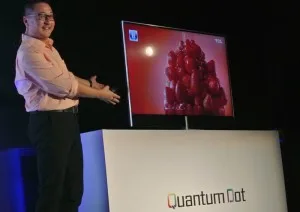
At CES, you could see many quantum-dot-enhanced TVs on the show floor, most of which will appear at retailers in the second half of the year. What you could not see on the floor were the makers of the quantum dots themselves. But they were there in Las Vegas, speaking with current and potential customers in hotel suites, where they often had compelling demonstrations to show.
Jason Hartlove, CEO of Nanosys (Milpitas, California) said that Samsung has licensed Nanosys’s cadmium-free quantum dots, which the company has been developing under the radar. The license agreement gives Samsung access to the Nanosys technology and specifies that Samsung will be manufacturing the dots. In addition, Nanosys is ramping up its line in Milpitas. Capacity is now 25 tonnes per year, enough for 10 million TVs.
Hartlove was pleased that Samsung had a major demo in its booth comparing quantum-dot enhanced LCD TVs to other technologies, including plasma and OLED. Samsung’s conclusion, boldly stated in the booth, is that quantum dots are better than OLED for television.
TCL gleefully announced its new line of QD-enhanced TVs and its association with QD Vision. (Photo: Ken Werner)Hartlove said this with an expression of happy wonderment on his face, but the position represents solid strategy for Samsung. Samsung has abandoned OLED-TV as not being a feasible high-volume technology, at least for the present, leaving LG in possession of the OLED field. But it’s a field whose value is debateable. By taking a strong position on the outright superiority of QD-enhanced LCD – rather than saying, as LG is, that it’s the best technology until OLED is ready for the mainstream – Samsung is attempting to reduce the value of LG’s OLED field even more.
Nanosys’s media guru Jeff Yurek added, “We’re very excited by HDR. OLED has troubles”.
Nanosys supplies 3M with the quantum dots it uses in its Quantum Dot Enhancement Film (QDEF). (Although “QDEF” is consistent with the names of other 3M optical enhancement products, Nanosys actually owns the name.)

